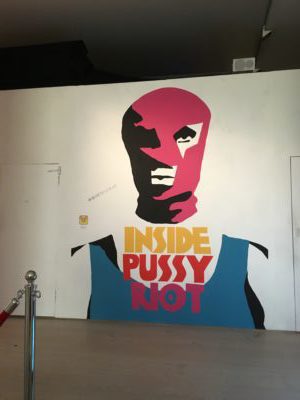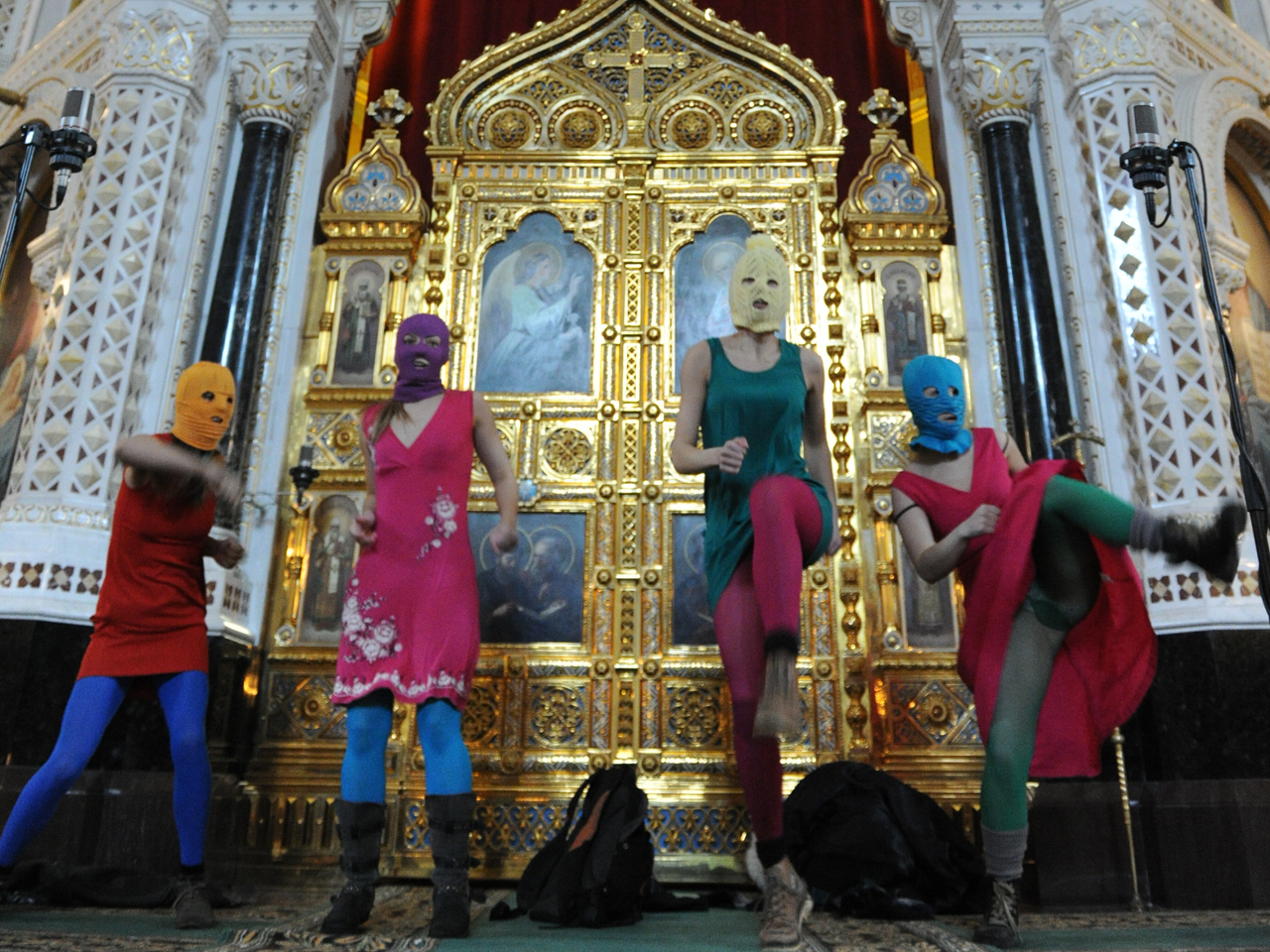


“Inside Pussy Riot” at the Saatchi Gallery was part of an exhibition called “Art Riot: Post Soviet Actionism.” The larger exhibition had a good deal of artwork/actions some of which were inspired by Pussy Riot’s example.
The Saatchi Gallery is large and grand, on the Duke of York Square which is a fashionable part of London. The fee for the performance called “Inside Pussy Riot” was 21 pounds, but we didn’t need to pay it because I am an art critic, but I kept thinking about how expensive it was!
The Guardian art critic. Charlotte Richardson Andrews called out the huge contradiction of revolutionary resistance inside such an upper crust space. Richardson in contrast celebrated the performance “Riot Days” by Maria Alychokhina, a one time event, at the Islington Town Hall. Alychokhina has also written a well received book called Riot Days. ( January 12: I just finished reading it and I can’t recommend it highly enough. The performance described below is intended to make us experience some of Maria and Nadia’s experiences in prison. Maria is a really impressive person, pursued resistance on behalf of the prisoners inside the prison, often at the expense of hostility from other prisoners who were punished on her behalf, and the guards as well, whom she called out, and won a case against their abuse. She held repeated hunger strikes in order to win better conditions for the women in the prisons where she was detained, she was released as part of an Olympic Amnesty by Putin in 2014)
Although I wasn’t expecting much of “Inside Pussy Riot,” I was surprised. I decided it was in fact a radical intervention in the Saatchi space, not a sell out. It intended to expose the abuses of the Russian prison system as the two Pussy Riot members who were jailed experience it. It was not simply about defying Putin, it was about oppression and injustice.
I was not allowed to take pictures so I will simply describe what happened.
The performance was put on by a theatrical group called Les Enfants Terribles in collaboration with the Tsukanov Family Foundation, a charity “which supports education of talended children from the Former Soviet Union countries. ” The actors were doing continuous performances with a new group of people coming through every 15 minutes, so it was extremely demanding for them. Hopefully the entry fee gave them appropriate compensation.

The performance put us inside the Russian penal system. The back story, which is familiar to most of us, is that the punk band invaded Cathedral of Our Savior Church in Moscow with a 40 second performance “Punk Prayer,””Mother of God Drive Away Putin ” in 2012 as a protest against Putin and his exploitation of religion, the misogyny of the church and the oppressive power of the state paired with religion.
(There is a film of the performance and arrests). 3 were arrested, 2 served a sentence, accused of Hooligansim. Pussy Riot had done other public interventions in Moscow and elsewhere protesting the state, but their arrest actually made them famous.
It also ended their position as carnivalesque protestors. Their balaclava masks were stripped off. Their identity as a collective of anonymous superheroes forever evaporated. The incarceration in the Russian penal system changed the two women into activists of a different type, activists for justice particularly for incarcerated women. It was the experience of the penal system that the performance re-created.
So the first room we entered was a church environment, with an altar with among others, Putin and Trump, and pillars underneath reading “poverty” and “pollution.” Other “stained glass windows” featured nuclear mushroom clouds. The design of the altar was actually similar to that of the cathedral where they had protested.
A priest was ranting at us about the sins of women.
We were given balaclava hoods in different colors with eye and mouth holes and placards with phrases like ” Wealth Does Not Define Success” “Imagination is not the Enemy” Dreaming is not Permitted” “Ask Nothing, Demand Nothing.” We held them up to a camera and protested.
In the next room, one person was asked to take off all their clothes. She refused, then reluctantly began to comply. When she got down to her underwear, she said she was one of the actors, but in the prison she would not have been able to refuse.
All of the aggressive officers (Enfants Terribles) who told us what to do were mean and rude.
The spaces got getting smaller and smaller. We entered a cell. On the other side of the wall of the cell was a judge placed up high in a “throne” that had a giant face subtly outlined on it, to one side was a large dog, to the other a shadow puppet on a pole. The phone rang, the judge answered, then she said in analyzing the evidence, she found us guilty. ( This part of the performance had an eerie and dreadful resemblance to the bail hearing I went to at the Northwest Detention Center for Pavel Bahmatov, who was included in the summarily analyzing the evidence he was promptly denied bail)
Then we noticed the judge was a puppet also, hanging on chains from the ceiling.
Next we went into a room in which we were instructed on how to behave in a penal colony – no physical contact, no eye contact; we removed the balaclavas and put on jump suits. We were told that all we could do was stare ahead as we were put at work tables, where we were asked to pursue a mindless task ( mine was cleaning coins with a toothbrush).
We went on to a room with a latrine, a disgusting space in which we were told of tortures done there for those who disobeyed.
We had “exercise”, forced movement, robot like.
Then last, ( worst, I was amazed I survived all this), solitary confinement in a dark room. While there we heard a recording that was a call to arms, to resist the system, and we were given another protest placard. when we came out we protested again with the placards.( that was a weak part of the event)
So it was immersive. It was intended to give us a sense of the coercion and pettiness, the intentional forced acts that limited us in every way.
It was a relief to get out of there!
The cyber feminist Russian writer/philosopher Alla Mitrofanova writes about Pussy Riot in the context of the history of feminism in Russia in the twentieth century. Russian feminism is originally embedded in the Russian Revolution, when abolishing marriage and the family and enabling all children to be raised collectively, while women worked was a radical idea for restructuring the position of women in society. “Feminist politics aimed to destroy the triple oppression of women: the patriarchal, the bourgeois and sexual in one shot.”
During the Stalin years, the family was brought back, so women were required to work and also do the work of the bourgeois household. Feminism returned only in the early 2000s in various forms, some more political, some more bourgeois.
According to Mitrofanova, Pussy Riot is a radical “reset of the political statement on the part of resistance .” ( ” The Public and the Political in Feminist Statements: Street Actions in St. Petersburg and the Pussy Riot Case,” n.paradoxa. vol 27 Jan 2011. ) . But she is also somewhat ambivalent referring to their “symbolic antagonism.”
My feeling is that any disruption is a positive, and even if they are currently on the road promoting their actions as a type of symbol of resistance, they still are activists, both within the context of the society in general as disruptive women, and in the context of the very passive smug and capitalistic art world. Their immersive performance definitely affected me more directly than any of the work on the walls of the Saatchi gallery. It actually accurately suggested the injustice and oppressions of justice systems.

If you are neutral in situations of injustice you have chosen the side of the oppressor Desmond Tutu
Image at the exit of “Inside Pussy Riot”